-
0
Patient Assessment
- 0.1 Patient demand
- 0.2 Overarching considerations
- 0.3 Local history
- 0.4 Anatomical location
- 0.5 General patient history
-
0.6
Risk assessment & special high risk categories
- 5.1 Risk assessment & special high risk categories
- 5.2 age
- 5.3 Compliance
- 5.4 Smoking
- 5.5 Drug abuse
- 5.6 Recreational drugs and alcohol abuse
- 5.7 Parafunctions
- 5.8 Diabetes
- 5.9 Osteoporosis
- 5.10 Coagulation disorders and anticoagulant therapy
- 5.11 Steroids
- 5.12 Bisphosphonates
- 5.13 BRONJ / ARONJ
- 5.14 Radiotherapy
- 5.15 Risk factors
-
1
Diagnostics
-
1.1
Clinical Assessment
- 0.1 Lip line
- 0.2 Mouth opening
- 0.3 Vertical dimension
- 0.4 Maxillo-mandibular relationship
- 0.5 TMD
- 0.6 Existing prosthesis
- 0.7 Muco-gingival junction
- 0.8 Hyposalivation and Xerostomia
- 1.2 Clinical findings
-
1.3
Clinical diagnostic assessments
- 2.1 Microbiology
- 2.2 Salivary output
-
1.4
Diagnostic imaging
- 3.1 Imaging overview
- 3.2 Intraoral radiographs
- 3.3 Panoramic
- 3.4 CBCT
- 3.5 CT
- 1.5 Diagnostic prosthodontic guides
-
1.1
Clinical Assessment
-
2
Treatment Options
- 2.1 Mucosally-supported
-
2.2
Implant-retained/supported, general
- 1.1 Prosthodontic options overview
- 1.2 Number of implants maxilla and mandible
- 1.3 Time to function
- 1.4 Submerged or non-submerged
- 1.5 Soft tissue management
- 1.6 Hard tissue management, mandible
- 1.7 Hard tissue management, maxilla
- 1.8 Need for grafting
- 1.9 Healed vs fresh extraction socket
- 1.10 Digital treatment planning protocols
- 2.3 Implant prosthetics - removable
-
2.4
Implant prosthetics - fixed
- 2.5 Comprehensive treatment concepts
-
3
Treatment Procedures
-
3.1
Surgical
-
3.2
Removable prosthetics
-
3.3
Fixed prosthetics
-
3.1
Surgical
- 4 Aftercare
頬骨インプラント
Key points
- 頬骨インプラントは、2回法および即時荷重プロトコルの両方ともエビデンスに基づく外科的・補綴学的ソリューションです。
- 頬骨インプラントは、現在では即時荷重プロトコルにより埋入されるのが一般的です。
- 頬骨インプラントの主な適応症は、重度に吸収された上顎無歯顎ですが、部分無歯顎でも適用することができます。
- 頬骨インプラントの適応症は、上顎洞底挙上術の代替、上顎洞底挙上術失敗、腫瘍切除または外傷後の機能修復、従来型インプラントの失敗、骨移植術の失敗です。
- 頬骨インプラントの埋入は、十分な訓練と手術経験を必要とします。
適応症
頬骨インプラントは、萎縮上顎臼歯部の機能修復のための選択肢の1つであり、典型的な2回法および即時荷重プロトコルのいずれによっても行うことができます。頬骨インプラントを使用すると、骨移植術や上顎洞底挙上術を回避することができるため、治療期間を短縮し、治療に伴う不快感を低減することができます。頬骨インプラントの他の適応症としては、従来型インプラントの失敗、上顎洞底挙上術または骨移植術失敗、腫瘍切除または外傷後の機能修復が挙げられます。
萎縮上顎臼歯部においては、概ね、左右に1本ずつ頬骨インプラントを埋入し、前歯部に2~4本の従来型インプラントを埋入します。
上顎が完全に吸収され、前歯部へのインプラント埋入が不可能な場合は、この概念を拡大し、前歯部寄りの領域にさらに2本の頬骨インプラントを挿入します(Quad zygoma)。現在、頬骨インプラントは、固定式ブリッジを用いた即時荷重により行われるのが一般的です。
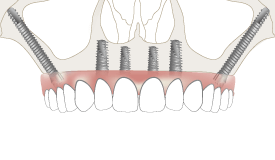
臨床的推奨事項
典型的なプロトコルでは、頬骨インプラントは歯槽頂および上顎洞を貫通して埋入し、頬骨に固定します(図1)。正確なインプラント位置を目視により確認するためには、上顎洞にアクセスする必要があります。上顎洞へのアクセスの準備はインプラント埋入位置の後側面で行い、シュナイダー膜を前方に挙上します。インプラントを埋入し、ほとんどは膜を穿孔せずに、上顎洞壁の内面に位置させます(図2)。
代替法として、上顎洞の合併症を低減し、インプラントの埋入位置およびエマージェンス・プロファイルを歯槽頂側によせるための上顎洞外埋入法も報告されています。
頬骨までのドリリング距離は長く、隣接する重要な解剖学的構造を保護する必要があるため、頬骨インプラントを埋入するためには、相当の手術訓練と経験に加え、綿密な診断計画を必要とします。解剖学的構造の全体像を適切に把握するためには、CTまたはCBCTによる術前の3次元プランニングが不可欠です。
即時機能プロトコルでは、最善の初期固定を得るため、全骨密度において35~45 Ncmの挿入トルクをかけるためのドリルプロトコルを適用します。挿入トルクが45 Ncmを上回る場合は、ツイストステップドリルのような適切なドリルステップの使用が推奨されます。
注意:挿入トルクが45 Ncmを超えてはなりません。締め付け過ぎると、インプラントの破損、骨折または骨壊死を引き起こすおそれがあります。
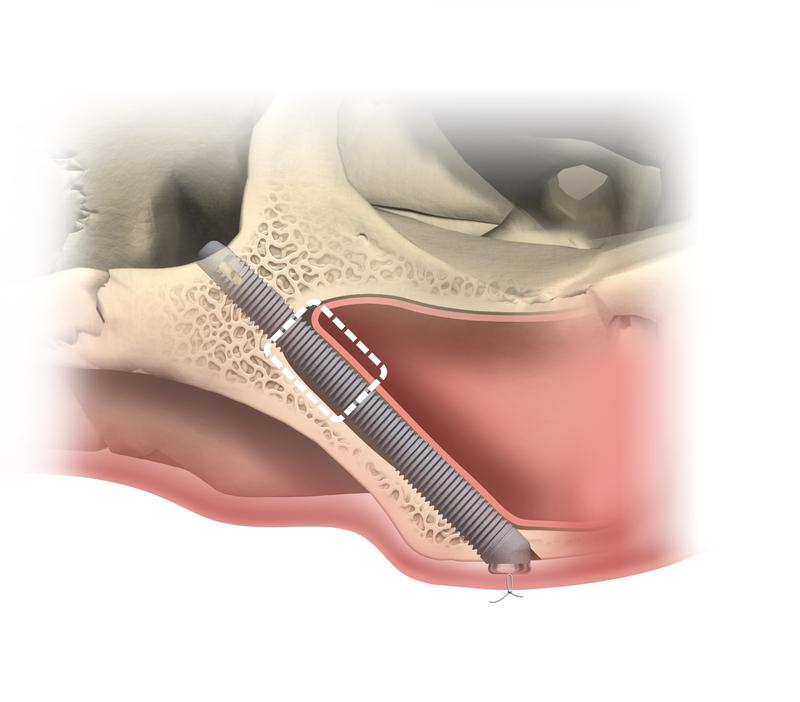
予後
典型的な2回法および即時荷重プロトコルによる長期プロスペクティブ試験では、高い成功率が報告されており、合併症もごく軽微でした。頬骨インプラントの12年後の累積残存率は96%です。
合併症
頬骨インプラントで最も多く報告されている合併症は、副鼻腔炎です。本合併症を低減ないし予防するためには、適切な術前診断と上顎洞の評価に加え、上顎洞外アプローチおよびインプラントの即時荷重を採用することが重要であると思われます。
ぽ頬骨インプラントの挿入時および挿入後の発生が報告されているその他の合併症としては、眼窩下神経の感覚異常(paresthesia)、口腔上顎洞フィステルおよび眼窩の穿孔等が挙げられます。
頬骨インプラントを用いた治療例
1.重度吸収上顎の4本の頬骨インプラントによる機能修復
本例は完全吸収上顎のため来院し、インプラント治療を受けたことはありませんでした。上顎に4本の頬骨インプラントを埋入し、上顎、下顎ともに既存の可撤式義歯を固定式のインプラント支持補綴物に変換しました。
<span itemprop="name" content="TG_casemov__to_2620_case1"></span> <span itemprop="description" content=""></span> <span itemprop="duration" content="108"></span> <span itemprop="thumbnail" content="http://cdnbakmi.kaltura.com/p/1320171/sp/132017100/thumbnail/entry_id/1_os356zsr/version/0"></span> <span itemprop="width" content="560"></span> <span itemprop="height" content="395"></span>
2.インプラント治療失敗後の4本の頬骨インプラント埋入
<span itemprop="name" content="TG_casemov__to_2620_case2"></span> <span itemprop="description" content=""></span> <span itemprop="duration" content="121"></span> <span itemprop="thumbnail" content="http://cdnbakmi.kaltura.com/p/1320171/sp/132017100/thumbnail/entry_id/1_z7ervg5v/version/100000/acv/181"></span> <span itemprop="width" content="560"></span> <span itemprop="height" content="395"></span>
3.ブローネマルクシステムザイゴマの教育用ビデオ
<span itemprop="name" content="ZYGOMA SYSTEM AUDIO Jose marcos Alvarez.avi"></span> <span itemprop="description" content=""></span> <span itemprop="duration" content="461"></span> <span itemprop="thumbnail" content="http://cdnbakmi.kaltura.com/p/1320171/sp/132017100/thumbnail/entry_id/0_jd8ehswi/version/100000"></span> <span itemprop="width" content="560"></span> <span itemprop="height" content="395"></span>
臨床トピック
Related articles
Additional external resources
Questions
Facial Nerve damage from Zygomatic Implants
I have suffered from nerve damage to my left cheek muscle to my nose from quad zygomatic implants.
is there any treatments to help this improve muscle movement such as acupuncture or laser?
I have suffered from nerve damage to my left cheek muscle to my nose from quad zygomatic implants.
is there any treatments to help this improve muscle movement such as acupuncture or laser?

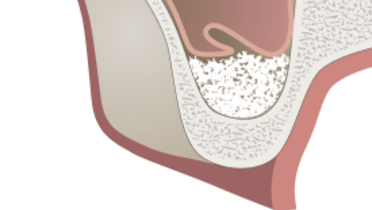
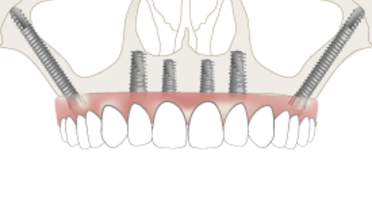
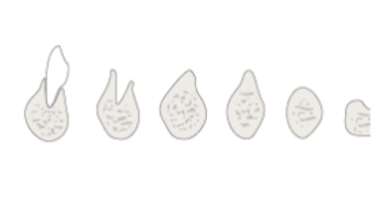
howw do you treat an abscess and sinus infection on a zygomatic implant
how do you treat an abscess and sinus infection on a zygomatic implant
how do you treat an abscess and sinus infection on a zygomatic implant